Physical and chemical analysis of Beirut ammonium nitrate blast: A concern of particulate matter in atmosphere
DOI:
https://doi.org/10.3126/njes.v10i2.43449Keywords:
Ammonium nitrate (AN), atmospheric degradation, explosion, particulate matter(PM)Abstract
Chemical disasters are caused by improper management, handling, transportation, and sudden accidents. The massive explosion of ammonium nitrate silo in the port of Beirut on August 4, 2020, has threatened the world with the loss of 220 people, about 6500 injuries, huge property loss, and environmental contamination. This paper aims to summarize the major ammonium nitrate accidents in the past 100 years in the world. We analyzed the accidents in terms of frequency, causes, property loss, and deaths. We reported 43 accidents in which 7 accidents triggered more than 100 casualties. Altogether seven terrorist attacks with ammonium nitrate are reported leading to the death of 411 people and huge loss of assets. The explosion releases a large amount of energy and produces a variety of gases along with nitrogen oxides, ammonia, and a lot of particulate matter (PM), which significantly contributes to air pollution. The size and amount of PM imposes negative impact on environment like low visibility, decreased solar radiation and adverse health impacts like chronic respiratory, pulmonary, cardiovascular, and other human diseases. Proper management and safety measures with stringent regulations at national and international level is warranted for the safe and sustainable use of industrial chemicals.
Downloads
Downloads
Additional Files
Published
How to Cite
Issue
Section
License
Copyright (c) 2022 Central Department of Environmental Science, Tribhuvan University

This work is licensed under a Creative Commons Attribution-NonCommercial 4.0 International License.
This license enables reusers to distribute, remix, adapt, and build upon the material in any medium or format for noncommercial purposes only, and only so long as attribution is given to the creator.

